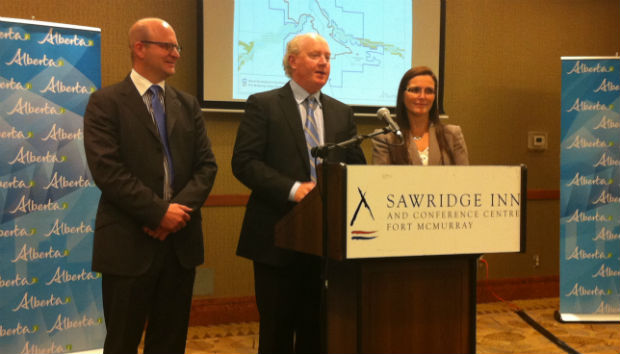The province is releasing enough land to the municipality to meet growth for the next 25 years.
It’s giving the city more than 55,000 acres, which is twice the size of Fort McMurray right now.
The RMWB’s population in 2012 was 76,000, and that number is on pace to double by 2030.
The land, known as the Urban Development Sub-Region, will be sold to the city in phases over the next 5 to 15 years.
It will allow for new housing, commercial properties, infrastructure, and new parks and recreation, and the municipality has the option of expanding to the south, east and west.
Mayor Melissa Blake says today has been her biggest as mayor of the municipality
“This is probably the most significant day that I’ve had because it guarantees that there will be no conflict under the boundaries or on the boundaries that we have now,” she said.
“Leases with industries have been cancelled to accommodate this community. It says to me that our community comes first.”
No oil sands development will be allowed on those lands, and all oil sands leases on that land will be cancelled, which affects 10-15 companies.
But developers of petroleum and natural gas, metallic and industrial minerals, and gravel will be allowed to continue.
All affected oil sands companies will have their leases cancelled immediately, and be compensated by the province.
Minister of Energy Ken Hughes helped make the announcement, and was honest about where he would give credit for getting the agreement done.
“I can tell everybody assembled here that this day would not have happened without the very deliberate and determined engagement and support of Mayor Melissa Blake,” he said.
The province will also explore what it’s calling ‘creative partnerships’ with the city, which could mean joint funding of provincial infrastructure projects, as part of the city paying the fair market value for the new land.
Those discussions will take place over the next few months.
Blake says the main thing is that the municipality has the power to make its own decisions.
“We’ve got to figure out what can happen, where it can happen, when it can happen. But the when is always going to be predicated by what your population is doing,” she said.
“If we’re going through a period of rapid growth, we’re going to be moving more quickly on trying to secure what we need for that accommodation. Versus what we’ve been left to deal with, which is just reacting after the fact.”
July 25, 2013







